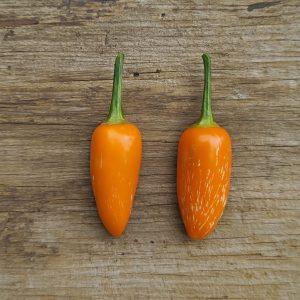Description
Product Name: African Birds Eye Chilli Seeds
Species: Capsicum frutescens
Common Names: African Birds Eye, Peri-Peri, Piri-Piri, Pili-Pili, African Devil
Type: Wild-type landrace; semi-domesticated Heirloom cultivar
Origin & Lineage
Geographic Origin: Native to central and southern Africa; introduced via Portuguese trade routes from South America
Development History: Although all Capsicum species originated in South America, the African Birds Eye pepper was introduced to the African continent in the late 15th century by Portuguese explorers, particularly through Mozambique. Over centuries, it adapted to African climates and soils, evolving into a distinct landrace known for its upright growth, intense heat, and small, conical fruits. It is now widely cultivated in countries like Malawi, Uganda, Zimbabwe, and South Africa, both commercially and in the wild.
Cultural Significance: African Birds Eye is a cornerstone of African cuisine and identity. It is the defining ingredient in Peri-Peri sauce, a fiery marinade used in Mozambican and Portuguese dishes. In Swahili-speaking regions, it’s called pilipili, and its use in stews, relishes, and meat rubs is deeply embedded in local culinary traditions. Beyond Africa, it has gained global fame through brands like Nando’s, which popularized Peri-Peri chicken.
Lineage / Hybridizer History:
The African Birds Eye is not a hybrid but a stabilized landrace of Capsicum frutescens. It shares lineage with the Tabasco pepper but is genetically distinct. Its upright fruiting habit and compact growth make it ideal for small-scale farming and container cultivation. No formal hybridizer is credited, as its evolution was shaped by centuries of natural selection and indigenous cultivation.
Heat Profile
Scoville Rating (SHU): 50,000–175,000 SHU
Perceived Heat: Hot to very hot—significantly hotter than jalapeño, comparable to Thai chili
Heat Characteristics: The burn is sharp and immediate, often described as a “needle-like sting.” It begins on the tongue and spreads quickly to the throat and cheeks. The heat lingers for several minutes and intensifies when dried. Despite its size, this pepper delivers a powerful punch and should be used sparingly in raw form.
Flavor Profile
Tasting Notes: African Birds Eye peppers offer a bold, fruity flavor with earthy undertones and a slightly smoky finish. Green pods are more herbaceous and grassy, while ripe red pods develop sweetness and depth. The flavor is clean and intense, making it ideal for Peri-Peri sauces and spice blends.
Aftertaste / Finish: The finish is warm and slightly bitter, with lingering heat and a peppery tail. Roasting enhances the smoky notes, while fermentation adds umami and complexity.
Ideal Pairings:
- Peri-Peri chicken and seafood marinades
- Mozambican stews and relishes
- Spicy pickled vegetables
- African-style bean dishes
- Peri-Peri sauces and infused oils
Fruit Characteristics
- Shape: Small, conical, tapered with blunt tip
- Size: 1–2 cm long, 0.5–1 cm wide
- Color Stages: Immature: green → Ripe: bright red or purple
- Wall Thickness: Thin
- Texture & Skin: Smooth, glossy, firm
Plant Details
- Growth Habit: Upright, bushy, shrubby
- Plant Height & Width: 45–120 cm tall, 30–60 cm spread
- Foliage: Dark green, ovate leaves
- Flower Color: White
- Days to Maturity: 90–150 days from transplant
- Yield: Moderate – 300 g per plant; ~1.8 metric tons per hectare
Cultivation Information
- Seed Count per Pack: 10 seeds
- Germination Time: 10–20 days (Germinating Chilli Seeds)
- Optimal Germination Temp: 24–30°C (Essential guide to ideal temperatures and humidity for chilli seed germination)
- Light Requirements: Filtered sun (minimum 6–8 hours/day)
- Soil Preferences:
- pH: 6.0–6.8
- Well-draining loam with compost (Easy DIY soil mixes)
- Avoid waterlogging; mulch to retain moisture
Storage Tips: Store African Birds Eye seeds in airtight containers in a cool, dry place. Refrigeration with desiccants can extend viability up to 3 years.
Notable Compounds
Capsaicinoid Content:
- High capsaicin and dihydrocapsaicin
- Heat varies by variety and growing conditions
Volatile Flavor Compounds:
- Limonene (citrus)
- Geraniol (floral)
- Methylpyrazine (smoke)
Anthocyanins / Pigments: Red and purple coloration due to carotenoids and anthocyanins
Culinary & Cultural Use
Traditional Uses: In African cuisine, this pepper is used in Peri-Peri sauce, chakalaka, bean stews, and meat rubs. It is often added whole to soups for slow-release heat or ground into powder for seasoning. In Portuguese and Brazilian cooking, it’s used in marinades and grilled dishes. Its versatility spans fresh, dried, pickled, and powdered forms.
Raw vs Cooked Flavor: Raw African Birds Eye pods deliver sharp heat and fruity brightness. Roasting adds depth and smokiness. Pickling preserves crunch and intensifies acidity. Fermentation enhances umami and balances the burn.
Regional Dishes:
- Mozambican Peri-Peri chicken
- South African chakalaka with bird’s eye heat
- Spicy bean stew with crushed pili-pili
- Peri-Peri sauce with garlic, lemon, and vinegar
- Pickled bird’s eye peppers for sandwiches and salads
Storage / Drying / Preserving Tips:
Dry pods whole or sliced in a dehydrator. Pickling is highly effective—use vinegar, garlic, and citrus for a balanced brine. Roasted peppers can be frozen or blended into sauces. For seed saving, allow pods to fully ripen and dry before extraction.






Reviews
There are no reviews yet.